Colostomy: Irrigating Your Colostomy
To irrigate, you need an irrigation kit, hook, and water-soluble lubricant. Before starting an irrigation program, get specific instructions from an enterostomal or wound-ostomy-continence healthcare provider. Irrigating a colostomy allows you increased control over the timing of your bowel movements. Once a day, or once every other day, you irrigate by flushing the colostomy with warm water.
Always wash your hands BEFORE and AFTER irrigating your colostomy.
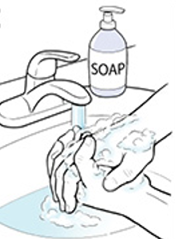 |
|
1. Fill the bag
- Close the clamp on the tubing attached to the irrigation bag.

- Fill the bag with 1 quart (4 cups) of warm water. Make sure the water is not too hot. Cold water can sometimes cause cramping.
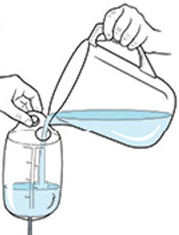
- Hang the bag on a hook above the toilet. The bottom of the bag should be about even with your shoulder when you sit.
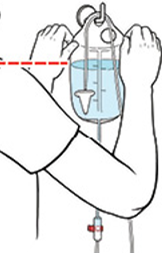
- Hold the tubing over the toilet. Open the clamp slightly to release any air in the tubing. Once water starts to come out, close the clamp.
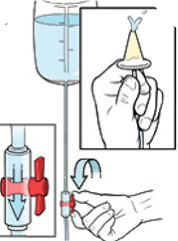
|
|
2. Put on the sleeve
- Remove the cap or pouch from your stoma.
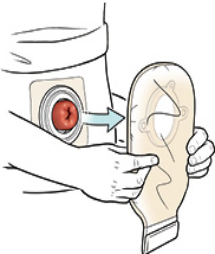
- Clean the skin around the stoma with warm water and a soft washcloth. Then dry it well.

- Sit next to the toilet. Place the round opening in the sleeve around the stoma. Press on the adhesive if the sleeve is self-adhering or attach the mounting ring and fasten the belt.
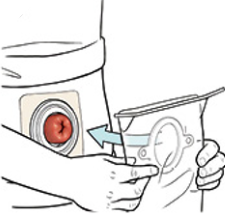
- Place the open end of the sleeve over the toilet.

|
|
3. Insert the cone
- Attach the cone to the tubing on the bag, and then rub a little lubricant on the tip of the cone.
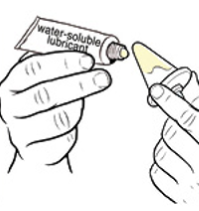
- Slip your hand through the opening at the top of the sleeve and put the cone into the stoma.
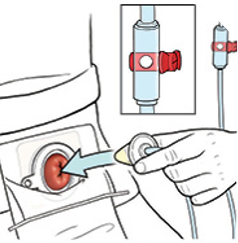
- Hold the cone in place and slowly open the clamp on the tubing. Allow the water to flow gently into the stoma. This should take 5 to 10 minutes. Then close the clamp on the tubing.
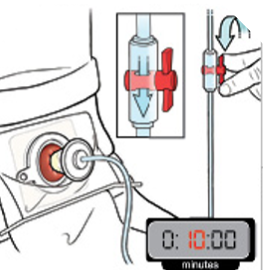
|
|
4. Remove the cone and clamp the sleeve
- Wait about 60 seconds after the water was infused.
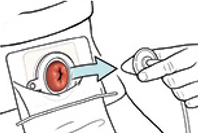
- Then remove the cone and seal the top of the sleeve.

- Allow stool and water to flow through the sleeve into the toilet for 15 to 20 minutes. Then you can clamp the bottom of the sleeve and get up if you want to. Complete return of water and stool may take up to 40-45 minutes.
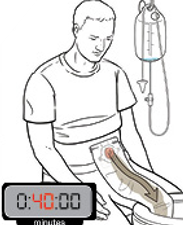
- When stool and water stop flowing, remove the sleeve. Empty the sleeve into the toilet.
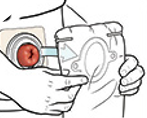
- Clean and dry the skin around the stoma.
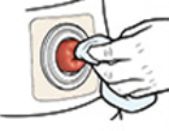
- Then cover the stoma with a cap or small pouch.
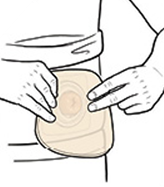
|
|
5. Clean the cone and the sleeve
- Rinse the cone and sleeve with water. If you wish, mix 1-part white vinegar with 3-parts warm water. Pour it into the sleeve. Hold the sleeve closed and shake it until the sides are clean. Then rinse with water.
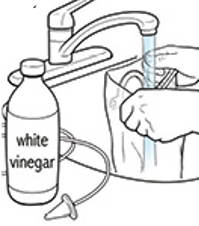
- Hang the sleeve to air-dry. Then wash your hands.
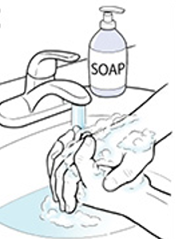
|
|
Things to Note:
- Cramping may occur while instilling water. This can be caused by the flow of the water being too fast or the water being too cold or too hot. If this happens, stop the irrigation until the cramps subside and then start again.
- If water does not go in or the irrigation fluid runs out around the cone, clamp the tube and reposition the cone to ensure that it is not resting up against the colon wall. The cone should be gently inserted into the stoma until it fits snugly.
- Do not irrigate the colostomy if you develop a hernia around your stoma.
- If there is no return, this may be a sign of dehydration. Stop irrigating, drink more fluids and wear a drainable pouch.
- Contact your doctor if you experience any adverse effects such as prolonged abdominal cramping, abdominal pain, prolonged distention after evacuation of stool, stoma swelling, nausea or vomiting.
|
Colostomy: Irrigating Your Colostomy
To irrigate, you need an irrigation kit, hook, and water-soluble lubricant. Before starting an irrigation program, get specific instructions from an enterostomal or wound-ostomy-continence healthcare provider. Irrigating a colostomy allows you increased control over the timing of your bowel movements. Once a day, or once every other day, you irrigate by flushing the colostomy with warm water.
Always wash your hands BEFORE and AFTER irrigating your colostomy.
 |
|
1. Fill the bag
- Close the clamp on the tubing attached to the irrigation bag.

- Fill the bag with 1 quart (4 cups) of warm water. Make sure the water is not too hot. Cold water can sometimes cause cramping.

- Hang the bag on a hook above the toilet. The bottom of the bag should be about even with your shoulder when you sit.

- Hold the tubing over the toilet. Open the clamp slightly to release any air in the tubing. Once water starts to come out, close the clamp.

|
|
2. Put on the sleeve
- Remove the cap or pouch from your stoma.

- Clean the skin around the stoma with warm water and a soft washcloth. Then dry it well.

- Sit next to the toilet. Place the round opening in the sleeve around the stoma. Press on the adhesive if the sleeve is self-adhering or attach the mounting ring and fasten the belt.

- Place the open end of the sleeve over the toilet.

|
|
3. Insert the cone
- Attach the cone to the tubing on the bag, and then rub a little lubricant on the tip of the cone.

- Slip your hand through the opening at the top of the sleeve and put the cone into the stoma.

- Hold the cone in place and slowly open the clamp on the tubing. Allow the water to flow gently into the stoma. This should take 5 to 10 minutes. Then close the clamp on the tubing.

|
|
4. Remove the cone and clamp the sleeve
- Wait about 60 seconds after the water was infused.

- Then remove the cone and seal the top of the sleeve.

- Allow stool and water to flow through the sleeve into the toilet for 15 to 20 minutes. Then you can clamp the bottom of the sleeve and get up if you want to. Complete return of water and stool may take up to 40-45 minutes.

- When stool and water stop flowing, remove the sleeve. Empty the sleeve into the toilet.

- Clean and dry the skin around the stoma.

- Then cover the stoma with a cap or small pouch.

|
|
5. Clean the cone and the sleeve
- Rinse the cone and sleeve with water. If you wish, mix 1-part white vinegar with 3-parts warm water. Pour it into the sleeve. Hold the sleeve closed and shake it until the sides are clean. Then rinse with water.

- Hang the sleeve to air-dry. Then wash your hands.

|
|
Things to Note:
- Cramping may occur while instilling water. This can be caused by the flow of the water being too fast or the water being too cold or too hot. If this happens, stop the irrigation until the cramps subside and then start again.
- If water does not go in or the irrigation fluid runs out around the cone, clamp the tube and reposition the cone to ensure that it is not resting up against the colon wall. The cone should be gently inserted into the stoma until it fits snugly.
- Do not irrigate the colostomy if you develop a hernia around your stoma.
- If there is no return, this may be a sign of dehydration. Stop irrigating, drink more fluids and wear a drainable pouch.
- Contact your doctor if you experience any adverse effects such as prolonged abdominal cramping, abdominal pain, prolonged distention after evacuation of stool, stoma swelling, nausea or vomiting.
|
Colostomy: Irrigating Your Colostomy
To irrigate, you need an irrigation kit, hook, and water-soluble lubricant. Before starting an irrigation program, get specific instructions from an enterostomal or wound-ostomy-continence healthcare provider. Irrigating a colostomy allows you increased control over the timing of your bowel movements. Once a day, or once every other day, you irrigate by flushing the colostomy with warm water.
Always wash your hands BEFORE and AFTER irrigating your colostomy.
 |
|
1. Fill the bag
- Close the clamp on the tubing attached to the irrigation bag.

- Fill the bag with 1 quart (4 cups) of warm water. Make sure the water is not too hot. Cold water can sometimes cause cramping.

- Hang the bag on a hook above the toilet. The bottom of the bag should be about even with your shoulder when you sit.

- Hold the tubing over the toilet. Open the clamp slightly to release any air in the tubing. Once water starts to come out, close the clamp.

|
|
2. Put on the sleeve
- Remove the cap or pouch from your stoma.

- Clean the skin around the stoma with warm water and a soft washcloth. Then dry it well.

- Sit next to the toilet. Place the round opening in the sleeve around the stoma. Press on the adhesive if the sleeve is self-adhering or attach the mounting ring and fasten the belt.

- Place the open end of the sleeve over the toilet.

|
|
3. Insert the cone
- Attach the cone to the tubing on the bag, and then rub a little lubricant on the tip of the cone.

- Slip your hand through the opening at the top of the sleeve and put the cone into the stoma.

- Hold the cone in place and slowly open the clamp on the tubing. Allow the water to flow gently into the stoma. This should take 5 to 10 minutes. Then close the clamp on the tubing.

|
|
4. Remove the cone and clamp the sleeve
- Wait about 60 seconds after the water was infused.

- Then remove the cone and seal the top of the sleeve.

- Allow stool and water to flow through the sleeve into the toilet for 15 to 20 minutes. Then you can clamp the bottom of the sleeve and get up if you want to. Complete return of water and stool may take up to 40-45 minutes.

- When stool and water stop flowing, remove the sleeve. Empty the sleeve into the toilet.

- Clean and dry the skin around the stoma.

- Then cover the stoma with a cap or small pouch.

|
|
5. Clean the cone and the sleeve
- Rinse the cone and sleeve with water. If you wish, mix 1-part white vinegar with 3-parts warm water. Pour it into the sleeve. Hold the sleeve closed and shake it until the sides are clean. Then rinse with water.

- Hang the sleeve to air-dry. Then wash your hands.

|
|
Things to Note:
- Cramping may occur while instilling water. This can be caused by the flow of the water being too fast or the water being too cold or too hot. If this happens, stop the irrigation until the cramps subside and then start again.
- If water does not go in or the irrigation fluid runs out around the cone, clamp the tube and reposition the cone to ensure that it is not resting up against the colon wall. The cone should be gently inserted into the stoma until it fits snugly.
- Do not irrigate the colostomy if you develop a hernia around your stoma.
- If there is no return, this may be a sign of dehydration. Stop irrigating, drink more fluids and wear a drainable pouch.
- Contact your doctor if you experience any adverse effects such as prolonged abdominal cramping, abdominal pain, prolonged distention after evacuation of stool, stoma swelling, nausea or vomiting.
|